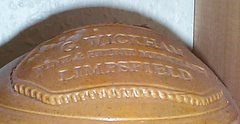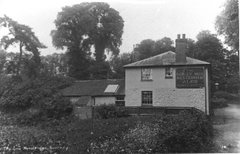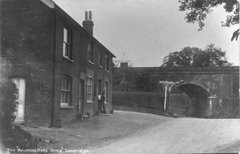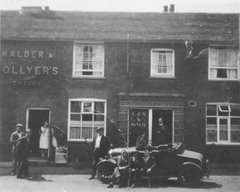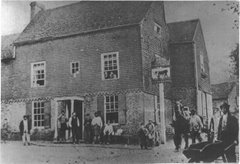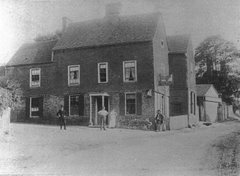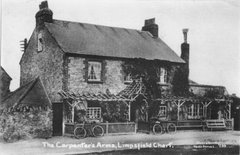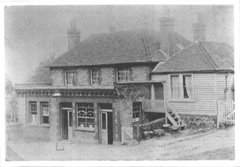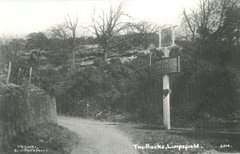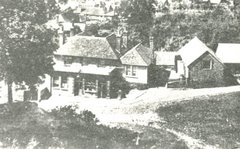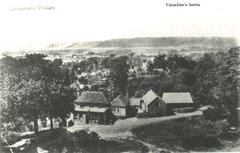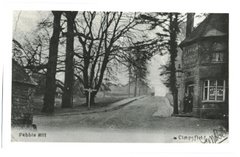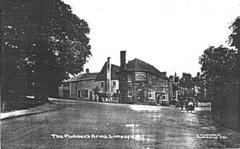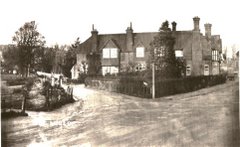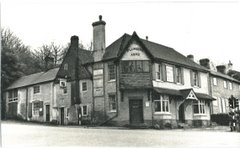I recently had an email from a reader who lives in Australia
who thought he had something that I may have been interested in. He told me
that his mother’s family were English and that her family owned a pub/inn in
Limpsfield at some stage over the years. Apparently when her family brought the pub the
previous owner gave them an old pewter pint and half pint mug and they were
told that they belonged to the famous General Wolfe who used to drink at the
pub. These have been handed down though the family over the years and have ended
up in his possession. He did admit that nobody in his family has researched
this much, but they all thought that perhaps the mugs had belonged to General
James Wolfe, the Wolfe of Quebec. This would put him drinking in a pub in
Limpsfield sometime in the early to mid 18th century. Both of the Pewter mugs
have clearly engraved "G Wolfe / Limpsfield" and what appears to be an
impressed stamp on the mug, the words SURREY 4 within a circle. The mugs appeared
to be very old and well used, and he wondered that if they did belong to
General Wolfe they could possibly be of historical value.
I had to point out to my reader
that as interesting this all is, obviously such items cannot have any true
value until they are supported by accredited provenance or paper trail linking
them to the purported former owner. Unfortunately, word of mouth is insufficient.
The paper link must relate directly with general Wolfe himself.
My first knee-jerk reaction is
that it could not possibly belong to General Wolfe. My reasons for this are
quite simple. Wolfe originally lived in Westerham, (just over the County
border, in Kent) at a house called "Spiers" now a National Trust
Museum called "Quebec House" and although it was only 3 miles away
from Limpsfield, he and his family had moved to Woolwich by 1737 when he was
aged only 11 - far too young to be drinking!! He was commissioned into the Army
as 2nd Lieut in 1741, aged 14 and immediately sent to Europe to fight in the
War of the Spanish Succession. He distinguished himself and was a Lieut.
Colonel by 1750, aged only 23. In 1748 he went to Scotland to help put down the
Jacobite rebellion (promoted to Major in 1749), and then to Ireland in 1752.
From thence he went to France the following year and promoted to Colonel in
1756 during the Seven Years’ War. Promoted again to Brigadier General in 1758 he
was sent to Canada, from whence he never returned home, dying of a fatal wound
before the Heights of Abraham, Quebec in 1759. Honestly, I cannot see when he
would have had time to travel from Woolwich to Limpsfield for a drink or two,
bearing in mind all through his adult life he would have returned home on leave
to his parent's home in Woolwich, if anywhere at all.
Secondly, his first name was
James, so the initial G. seems inappropriate - nor could the mugs have belonged
to his father as his father’s first name was Edward.
So where does this leave us? The mugs have subsequently shown to the
Pewter Society (yes, there is a society for almost everything!) and their
report stated "This style of pewter pot with a truncated cone body came in
around 1730 and remained popular throughout the 19th century. The Surrey 4 is a
verification mark put on by the Excise Inspector when he checked that the
publican was not giving short measure. In this case it was the Inspector from
Godstone in Surrey and the mark dates from 1855."
So it all sounds like this was an old family tale and no one in the reader's family is alive any more who knows much about how they ended up with them or where they came from.
My own thoughts as to whom the G. Wolfe might refer to, could more likely be associated with a Wolfe family (of whom there were many in the parish) who were totally unrelated to General Wolfe. There was quite a clan of Wolfes in Limpsfield at the time-frame in question, particularly in the early part of the 19th century, several members of which clan are buried in St Peter's Churchyard.
I further wonder if there might be a connection with the Wolf family who were responsible for the construction of Wolf's Row, Limpsfield.
Anybody got any thoughts of their own?
So it all sounds like this was an old family tale and no one in the reader's family is alive any more who knows much about how they ended up with them or where they came from.
My own thoughts as to whom the G. Wolfe might refer to, could more likely be associated with a Wolfe family (of whom there were many in the parish) who were totally unrelated to General Wolfe. There was quite a clan of Wolfes in Limpsfield at the time-frame in question, particularly in the early part of the 19th century, several members of which clan are buried in St Peter's Churchyard.
I further wonder if there might be a connection with the Wolf family who were responsible for the construction of Wolf's Row, Limpsfield.
Anybody got any thoughts of their own?


































